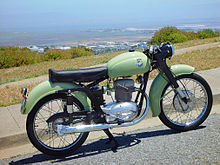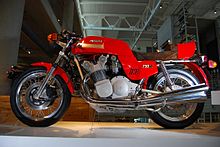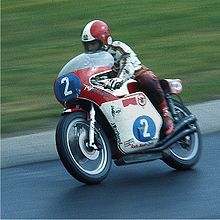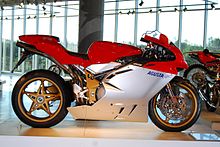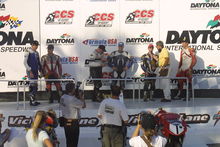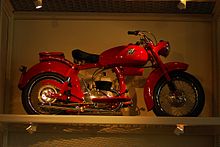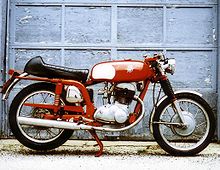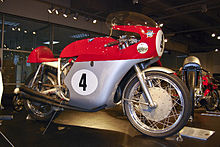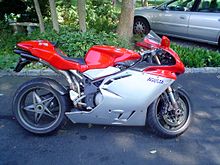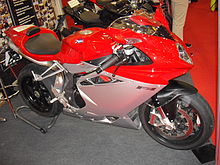- MV Agusta
-
MV Agusta Motor S.p.A. 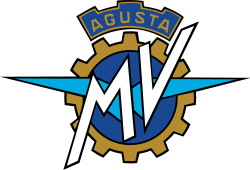
Type Private Industry Motorcycle Founded 1945 Headquarters Varese, Italy Key people Giovanni Castiglioni, President Products MV Agusta
CagivaParent MV Agusta Motor Holding, S.r.l. Website mvagusta.it MV Agusta is a motorcycle manufacturer founded in 1945 near Milan in Cascina Costa, Italy. The company began as an offshoot of the Agusta aviation company formed by Count Giovanni Agusta in 1923. The Count died in 1927, leaving the company in the hands of his wife and sons, Domenico, Vincenzo, Mario and Corrado. Count Vincenzo Agusta together with his brother Domenico formed MV Agusta at the end of the Second World War as a means to save the jobs of employees of the Agusta firm and also to fill the post-war need for cheap, efficient transportation. The initials MV stood for Meccanica, or mechanics, Verghera, the city in Italy where the first MV's were made. The company manufactured small-displacement, Café racer style motorcycles (mostly 125 to 150 cc) through the 1950s and 1960s. In the 1960s small motorcycle sales declined, and MV started producing larger displacement cycles in more limited quantities. A 250 cc, and later a 350 cc twin were produced, and a 600 cc four-cylinder evolved into a 750 cc.
Contents
History
Racing philosophy (1945-1971)
Count Vincenzo and Domenico Agusta had a passion for mechanical workings and for motorcycle racing. Much like Enzo Ferrari, they produced and sold motorcycles almost exclusively to fund their racing efforts. They were determined to have the best Grand Prix motorcycle racing team in the world and spared no expense on their passion. MV Agusta produced their first prototype, called "Vespa 98", in 1945. After learning that the name had already been registered by Piaggio for its Vespa motorscooter, it was referred to simply by the number “98”. In 1948, the company built a 125 cc two-stroke single and entered Franco Bertoni in the Italian Grand Prix. Bertoni won the event held in Monza and instantly put the new motorcycle manufacturer on the map.
In the 1949 season, the 125 cc or Ultra light weight class gained new prestige. More motorcycle manufacturers were competing in the inaugural World Championships that were held in Switzerland, Netherlands and Italy. The Mondial 125 cc DOHC design dominated the 1949 season. The MV riders placed 9th and 10th in the final standings. In 1950, Arturo Magni and Piero Remor joined the company after working with Gilera. Magni was the chief mechanic and Remor was chief designer.[1] The 1950 season and 1951 season were development years, as the company adopted the 125 Dohc four-stroke engine. Racing efforts only produced a fifth place finish at the Dutch TT in 1950. The 1951 results were only slightly better.
The 1952 season saw the introduction of telescopic forks, full width alloy brake hubs and a sleek fuel tank on the 125 race bike. Power was 15 bhp (11 kW) @ 10800 rpm. Britain's Cecil Sandford piloted the new MV 125 to a 1952 Isle of Man TT victory and went on to win MV Agusta's first world championship.
With the success of the 1952 season, independent or "privateer" riders could now purchase a "catalog" version of the 125 Dohc, now available through the company. The Sport Competizione racer had many of the same features as the factory bike. These included a multi-plate clutch, gear-driven oil pump, Dell'Orto 27mm SS1 carburetor and remote float chamber. The bike was nicknamed “The Boy Racer”. In 1953 the race engineers adopted the Earl-type forks to help with handling problems on the works racers. The 1953 season saw the introduction of the 350 Four. MV’s racing efforts now included the 500 cc, 350 cc and 125 cc class.
1953 saw the introduction of a new 175 cc overhead cam model. MV Agusta produced the 175 CST and CSTL (Turismo Lusso) for street use and soon developed a sportier 175 cc version with larger carburetor, a larger cylinder head with bigger fins, aluminum wheel rims and plenty of glossy red paint. The first year version (1954) of the 175 Sport featured a beautifully sculpted fuel tank that quickly earned it the unofficial nickname "Disco Volante" ("flying saucer") as, viewed from the front, the tank shape was reminiscent of a flying saucer. Soon after, MV began offering a very limited-availability racing version 175 cc "Super Sport" for MSDS racing (production club racing) equipped with unusual Earles-design front forks. In 1955, it was superseded by a new and improved Super Sport model with radical new styling and a 5-speed gearbox. It's design earned it the nickname "Squalo" (Shark). This 175 cc racing machine was very popular in Britain in the mid 1950s, where tuners learned to bore it out to over 200cc capacity. Racers including Micheal O’Rourke, Derek Minter, and Bob Keeler raced the 175 and 125 Sport Competizione around Europe with a great deal of success. The marketing strategy of "race it on Sunday, sell it on Monday" was adhered to, and it worked. MV street motorcycles enjoyed immense popularity throughout Europe. In 1958 American rider Dave Schuler, riding a borrowed and barely modified MV 175 Sport street bike, won the 175 class at the famed Catalina Island GP off-road race, in California.
After the 1957 season, the Italian motorcycle manufacturers Gilera, Moto Guzzi and Mondial jointly agreed to withdraw from Grand Prix competition due to escalating costs and diminishing sales. Count Agusta originally agreed to withdraw, but then had second thoughts. MV Agusta went on to dominate Grand Prix racing, winning 17 consecutive 500 cc world championships. Count Agusta's competitive nature usually saw him hire some of the best riders of the time, namely Carlo Ubbiali, John Surtees, Mike Hailwood, Giacomo Agostini, Phil Read, among others, and having the best engineers, most notably Arturo Magni. The three- and four-cylinder race bikes were known for their excellent road handling. The fire-engine red racing machines became a hallmark of Grand Prix racing in the 1960s and early 1970s.
Loss of the guiding force (1971 - 1980)
With the death of Count Domenico Agusta in 1971, the company lost its guiding force. The company won their last Grand Prix in 1976 and by the 1980 Grand Prix motorcycle racing season they were out of racing. Shortly thereafter, they ceased motorcycle production. Between 1948 and 1976 MV Agusta motorcycles had won over 3000 races and 63 World Championships overall. After MV Agusta left the racing scene in 1980, Magni began producing his own custom-framed MV motorcycles.[2]
Resurrected by Cagiva (1991 - 1999)
Cagiva purchased the MV Agusta name trademarks in 1991. In 1997 it introduced the first new MV Agusta motorcycle. The new bikes were four-cylinder 750 cc sports machines, the F4 range, which included a series of limited production run models, such as the all black paint work SPR model ("Special Production Racing") which was featured in the movie I, Robot. In 2004 they introduced their first 1,000 cc bike. 2004 marked the end of production for the 750 sports machines, with a limited production of 300 SR (Special Racing) model in the traditional red and silver livery.
MV Agusta also made a limited number of F4 750 cc and F4 1,000 cc Senna editions in memory of the late Formula One Champion Ayrton Senna, an avid Ducati and MV Agusta collector, in aid of the Instituto Ayrton Senna, his charity foundation in Brazil for children and young people. Three hundred of each model were made in the early 2000s.
They also produce a range of 750 and 910 naked bikes called the Brutale. Production is limited, as it is the policy of the company to produce an elite machine similar to Ferrari in motor cars. They do not compete directly with Japanese manufacturers, whose motorcycles typically sell for considerably lower prices; rather, they compete with other Italian models such as Ducati's sports bikes 996, 998, 999, 1098, and the naked Monster. In 2005 MV Agusta introduced the Tamburini 1000, which is named after its creator, Massimo Tamburini, who had previously worked for Ducati, where he designed the Ducati 916. Cycle World and Australian Motorcycle News magazine named it the best sportbike in the world.[citation needed] Tamburini designed the Ducati 916 sports bike (predecessor of the 748 and 996 series) which marked the return of Ducati as a successful motorcycle manufacturer in the early twentyfirst century. The MV Agusta F4 refined the innovative design of the 916. Claimed power of the new F4 312R model is 183 hp (136 kW). In 1999 the Cagiva group was restructured for strategic purposes and MV Agusta become the main division, comprising Cagiva and Husqvarna.
Since 1999
Heavily in debt, the manufacturer was bought by Malaysian car maker Proton in December 2004 for €70 million. In December 2005 Proton sold MV Agusta to GEVI SpA, a Genoa-based financing company related to Carige, for a token one euro excluding debt. By 2006 GEVI SpA, with 65% of the share capital, had refinanced MV Agusta, allowing the company to continue, in its native Italy.
In July 2007 MV Agusta Motor S.p.A, sold the Husqvarna motorcycle brand to BMW for an undisclosed amount.[3] According to MV Agusta president Claudio Castiglioni, the sale was a strategic step to concentrate all of the company's resources in order to expand MV Agusta and Cagiva presence in the international markets having more financial resources for new model development.[3]
Following years of stalled ownership, the Guggenheim's "Art of the Motorcycle" icon, the F4 model, was ready for a refresh, but the financial status of the company did not allow it. On July 11, 2008, Harley-Davidson announced they had signed a definitive agreement to acquire the MV Agusta Group for US$109 million (€70m),[4][5] completing the acquisition on August 8, 2008.[6]
On October 15, 2009, Harley-Davidson announced that it would divest its interest in MV Agusta;[7] on August 6, 2010, Harley-Davidson announced that it had concluded the sale of MV Agusta to Claudio Castiglioni and his wholly owned holding company, MV Agusta Motor Holding, S.r.l.
MV Agusta announced that for the first three months of 2010 bike sales increased by 50%.[8]
Racing history
The glory (1948 - 1980)
The name of MV Agusta became popular in 1948 when Franco Bertoni won the Italian Grand Prix. By that time MV Agusta adopted the commercial slogan: "Racing experience at the service of mass production."
The manufacturer started a domination in all class in 1956. They won the 125cc, 250cc and 500cc class simultaneously in 1956, 1958, 1959 and 1960. The manufacturer won 270 Grand Prix motorcycle races, with legendary riders such as Giacomo Agostini, Mike Hailwood, Phil Read, Carlo Ubbiali, Gary Hocking and John Surtess.
MV Agusta says on its USA Website about that period: "Dressed in red and silver, these invincible ‘record machines' took the hearts of all fans sensitive to the esoteric charm of the inline four cylinder. An engine endowed with an extraordinary force largely underlined by the four megaphone-like exhausts, responsible for an unforgettable and terrifying roar. Distinguishing features that could not remain an exclusive heritage of the fortunate witnesses of that unforgettable era, needed to testify also in the future."[9]
MV Agusta won the following World Titles:
- 500cc class (John Surtees, Gary Hocking, Mike Hailwood, Giacomo Agostini)
- 1956, 1958 to 1974
- 250cc class :
- 1956, 1958 to 1960
- 125cc class :
- 1952, 1956, 1958 to 1960
MV Agusta also won races in the famous Tourist Trophy. Giacomo Agostini made his Tourist Trophy debut in 1965 in the Junior class on an MV 350 three cylinder and finish third. He participated in 16 TT races, all on MV Agustas, he won the race 10 times, retired 3 times and was on the podium in the other races. He completed a Senior/Junior double in 1968, 1969, 1970 and 1972. Mike Hailwood won the Tourist Trophy on a MV Agusta 4 times, 3 on Senior class and 1 in Junior class. John Surtees turned to MV Agusta in 1956 and won the Senior class. In 1958, he finish the Junior and Senior class in 1st position, a feat he repeated in 1959. He also won the 1960 edition. MV Agusta won the Tourist Trophy 34 times.
Return to racing
Although there were no factory racing efforts, independent ("privateer") teams were racing the F4 750. In 2003 Big Show Racing of Chicago Illinois, USA fielded an F4 750 in the Formula USA, Daytona International Speedway 200 Mile Team Challenge. The team placed second overall with riders Larry Denning and Aaron Risinger piloting the bike.[10]
In May 2007 the company confirmed its return to racing in the 2008 Superbike World Championship season. Carl Fogarty's English-based Team Foggy Racing was going to run the team;[11] Fogarty however abandoned the plans to return to the Superbike World Championship because of lack of sponsorship.[9]
MV Agusta in 2008 competed in the Italian Superbike Championship. Luca Scassa won the Italian Superbike Championship on a MV Agusta factory-backed machine from the racing department in Schiranna, Varese Italy.[12]
Classic product history
Classic street models (1946 – 1980)
- 98 cc 1946–1949
- 125 Twin 1947
- 125 3-Speed 1948–1949
- 125 TEL 1949–1954
- 125 CSL Scooter 1949–1951
- 250 1947–1951
- 125 Motore Lungo 1950–1953
- 125 CGT Scooter 1950–1952
- 500 Turismo 1950
- Ovunque Scooter 1951–1954
- 150 1952–1953
- 175 CS 1953–1959
- Pullman 1953-1956
- 125 Turismo Rapido 1954–1958
- 48 Moped 1955–1959
- Superpullman 1955–1957
- 300 Twin 1955
- Raid 250 cc and 300 cc 1956–1962
- Ottantatre 83 cc 1958–1960
- 175 A B 1958-1959
- 125 TREL. Centomila 1959–1963
- 150 4T 1959–1970
- Chicco Scooter 1960–1964
- Tevere 235 1959–1960
- Checca ( 83 cc, 99 cc, 125cc ) 1960–1969
- Liberty 50 cc 1962–1969
- Germano 50 cc 1964–1968
- Arno 166 GT 1964–1965
- 125 GT-GTL 1964–1973
- 125 Regolarita 1965–1970
- 250 Twin 1966–1971
- Four Cylinder series 1965–1980
- 600 tourer
- 750 GT
- 750SS
- 750 Sport (drum brake) 1972–1974
- 750 Sport (Disc brake) 1974
- 750 Sport America 1975–1978
- 850SS
- MV Agusta 350B Sport 1970–1974
- 350 Ipotesi 1975–1980
- 125 Sport 1975–1980
Race models (1946 – 1976)
- 98/125 Two Stroke 1946–1949
- 125 Twin-Cam 1950–1960
- 500 cc Shaft Drive Four
- MV Agusta 125 Sohc 1953–1956
- 175 Twin-Cam 1955–1958
- 250 Single 1955–1959
- 350 Twin 1957
- 250 Twin 1959–1966
- 500 cc Six Cylinder 1957–1958
- 125 Disc Valve 1965
- 350 cc Three Cylinder 1965–1973
- MV Agusta 500 Three 1966–1974
- 350 cc Six Cylinder 1969
- 350 cc Four Cylinder 1971–1976
- 500 cc Four Cylinder 1973–1976
Modern product history (from 1998)
MV Agusta F4 750cc
- F4 750 S (2000)
- F4 750 S 1+1 (2000)
Limited Editions
- F4 ORO (1999)
- F4 750 Senna (2003)
- F4 SPR (2004)
- F4 750 Agostini (2004)
- F4 750 S Limited Edition America (2005)
MV Agusta F4 1000cc (First model)
- F4 1000 S (2005)
- F4 1000 S 1+1 (2005)
- F4 1000 R (2006)
- F4 1000 R 1+1 (2006)
- F4 1000 R 312 (2007)
- F4 1078 RR 312 (2008)
Limited Editions
- F4 AGO (2005)
- F4 Mamba (2005)
- F4 Tamburini (2005)
- F4 1000 Senna (2005)
- F4 1000 SP-01 (2005)
- F4 Corse (2006)
- F4 1000 Veltro (2006)
- F4 1000 CR Platino (2007)
- F4CC - Claudio Castiglioni (2007)
- F4 1000 R 312 Scuderia Ferrari (2010)
MV Agusta F4 1000cc (Second model)
- F4 1000 R (2010)
- F4 1000 RR (2011)
Limited Editions
- F4 1078 RR 312 Edizione finale (2010)
- F4 1000 R Frecce Tricolori (2010)
- F4 1000 RR edition 50ans école d’aviation de chasse (2011)
MV Agusta F3 675cc
- F3 675 (2011)
Limited Editions
- F3 675 ORO (2011)
MV Agusta Brutale 750cc
- Brutale 750 S (2003)
Limited Editions
- Brutale 750 ORO (2002)
- Brutale 750 S America (2005)
- Brutale 750 S CRC (2005)
- Brutale 750 S Gladio (2005)
MV Agusta Brutale 1000cc (First model)
- Brutale 910 S (2006)
- Brutale 910 R (2007)
- Brutale 1078 RR (2008)
- Brutale 989 R (2008)
Limited Editions
- Brutale 910 R Italia (2007)
- Brutale 910 R Wally (2007)
- Brutale 1078 RR Jean Richard (2009)
MV Agusta Brutale 1000cc (Second model)
- Brutale 990 R (2010)
- Brutale 1090 R (2010)
- Brutale 920 (2011)
Limited Editions
- Brutale 910 R Starfighter (2010)
- Brutale 990 R Brand Milano (2010)
- Brutale 1090 RR Cannonball (2010)
See also
References
- ^ MV Agusta All production road and racing motorcycles. Mick Walker. Osprey Publishing Limited
- ^ Neale Bayly (January/February 2008). "1983 861 Magni MV Agusta". Motorcycle Classics. http://www.motorcycleclassics.com/motorcycle-reviews/1983-861-magni-mv-agusta.aspx. Retrieved 2009-08-10.
- ^ a b BMW Buys Husqvarna From MV Agusta roadracingworld.com retrieved on September 30, 2007
- ^ "Harley-Davidson Acquires Both MV Agusta & Cagiva!". SuperbikePlanet.com. http://www.superbikeplanet.com/2008/Jul/080711b.htm. Retrieved 2008-07-11.
- ^ "Harley-Davidson to acquire Mv Agusta Group expanding presence in Europe". Harley-Davidson.com. http://www.harley-davidson.com/wcm/Content/Pages/HD_News/Company/newsarticle.jsp?locale=en_US&articleLink=News/0292_press_release.hdnews&newsYear=2008&history=news. Retrieved 2008-07-11.
- ^ Harley-Davidson Completes Acquisition of MV Agusta
- ^ Barrett, Rick (15 October 2009), "Harley drops two lines, income plummets", Milwaukee Journal Sentinel (Milwaukee, Wisconsin), ISSN 1082-8850, http://www.jsonline.com/business/64352232.html
- ^ Michele Coppola (2010-03-26). "MV Agusta: Sales Increased by 50%! | Motorcycle News". Ultimatemotorcycling.com. http://www.ultimatemotorcycling.com/2010_MV_Agusta_Sales_Results_Increase. Retrieved 2010-06-26.
- ^ a b [1] www.mvagustausa.com History section 2011
- ^ Roadracing World & Motorcycle Technology Magazine. December 2003 Vol. 13 #12
- ^ "Fogarty team confirms 2008 return". BBC SPORT. May 2, 2007. http://news.bbc.co.uk/sport1/hi/motorsport/motorbikes/6613129.stm. Retrieved May 19, 2010.
- ^ "MV Austa racing program for the 2008 season". mvagusta.com. http://www.mvagusta.com/_vti_g2_nwArt.aspx?idnews=662&rpstry=26_. Retrieved 2008-03-27.
External links
Major and notable Italian motorcycle marques Categories:- Motorcycle manufacturers of Italy
- Companies established in 1945
- Italian brands
- Harley-Davidson
- 500cc class (John Surtees, Gary Hocking, Mike Hailwood, Giacomo Agostini)
Wikimedia Foundation. 2010.

